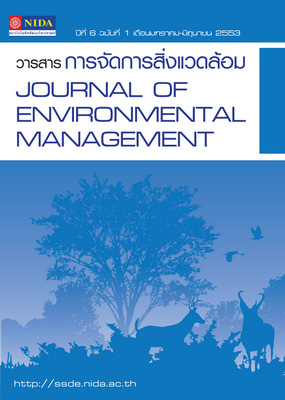ธรรมาภิบาลในการจัดการสิ่งแวดล้อมขององค์กรปกครองส่วนท้องถิ่น: กรณีศึกษาเทศบาลเมืองศรีราชา จังหวัดชลบุรี/Good Governance in Environmental Management of Local Authority: A Case Study of Siracha Municipality, Chonburi
บทคัดย่อ
การวิจัยเรื่องนี้เพื่อศึกษาผลการดำเนินการด้านสิ่งแวดล้อม วิเคราะห์การจัดการด้านสิ่งแวดล้อมของเทศบาลเมืองศรีราชา โดยประยุกต์แนวคิดด้านธรรมาภิบาล และสรุปเป็นบทเรียนในการบริหารจัดการด้านสิ่งแวดล้อมตามหลักธรรมาภิบาล สำหรับองค์กรปกครองส่วนท้องถิ่นอื่นๆ ทำการศึกษาโดยการประเมินการดำเนินงานด้านสิ่งแวดล้อมของเทศบาลเมืองศรีราชา ตามหลักธรรมาภิบาลใน 6 มิติ ผลการศึกษาพบว่า เทศบาลเมืองศรีราชามีการจัดการสิ่งแวดล้อมตามหลักธรรมาภิบาลครบทุกข้อ วิเคราะห์ได้ว่า ปัจจัยภายในที่เป็นจุดแข็ง ได้แก่ ผู้บริหาร บุคลากร การมียุทธศาสตร์และแผนงานของโครงการด้านสิ่งแวดล้อมที่ชัดเจน การจัดสรรงบประมาณ การนำเทคโนโลยีมาใช้ สร้างวัฒนธรรมและค่านิยมที่ดีในองค์กร ส่วนจุดอ่อน ได้แก่ บุคลากรในระดับปฏิบัติงานไม่เพียงพอ นโยบายยังไม่ครอบคลุมปัญหาสิ่งแวดล้อมทั้งหมดและโครงสร้างการบริหารยังมี ลักษณะเป็นระบบราชการ ปัจจัยภายนอกที่เป็นโอกาส ได้แก่ พื้นที่เป็นแหล่งเศรษฐกิจและแหล่งท่องเที่ยว ความร่วมมือจากผู้นำชุมชนและประชาชน และหน่วยงานต่างๆ ข้อจำกัด ได้แก่ สภาพพื้นที่ และประชากรแฝงบทเรียนสำหรับองค์กรปกครองส่วนท้องถิ่นอื่นๆ ได้แก่ การมีวิสัยทัศน์ความมุ่งมั่นและเสียสละของผู้บริหาร การให้ความสำคัญกับการดูแลรักษาทรัพยากรและสิ่งแวดล้อม การสร้างความเข้มแข็งของชุมชน ส่งเสริมการมีส่วนร่วม มีการศึกษาความเหมาะสมของโครงการและตรวจสอบติดตามประเมินผลอย่างต่อเนื่อง สร้างจิตสำนึกที่ดีในการอนุรักษ์สิ่งแวดล้อม และการได้รับความร่วมมือจากหน่วยงานภายนอกและองค์กรต่าง ๆ
The objectives of this research were to examine environmental management performance of Sriracha Municipality to analyze environmental management of the municipality by applying the good governance concept and to conclude lessons learned on environmental governance for other local authorities. The study evaluated environmental performance of Sriracha Municipality in 6 dimensions. It was found that Sriracha Municipality can operate in all dimensions. Internal factors which are the strengths included leaders, personnel, environmental strategies, plans and projects, sufficient budget, adopting technology, and creating good culture and values in the organization. The weaknesses were insufficient personnel at the operation level, environmental policies not covering all issues, and the bureaucratic administrative structure. External factors which are the opportunities included location suitable for development and tourism, and cooperation from community leaders. The threats were physical conditions of the area and unregistered population. Lessons for other local authorities are the vision and commitment of the executives, focusing on conserving resources and environment, strengthening communities capacity, promoting participation, studying the suitability of projects with continuous monitoring, raising people’s awareness on environmental conservation, and getting cooperation from external organizations.



